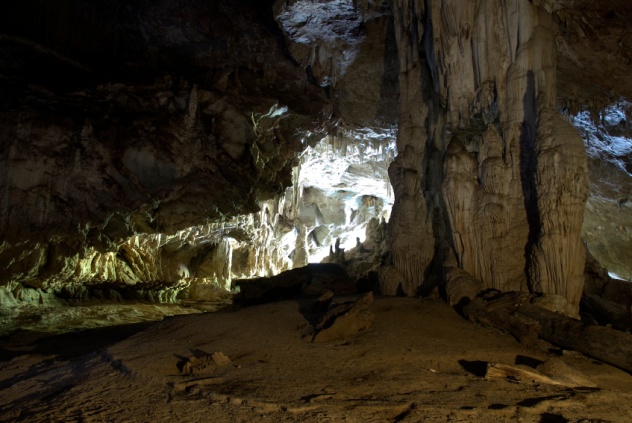Or is it? In spite of all our miraculous tech, we’re still a long way from understanding even some basic things about our planet. Here are 10 intriguing mysteries still surrounding our world.
10 The Unmapped Regions Of Our Greatest Cities
Typically, this is because it’s extremely dangerous to do so. The Neza-Chalco-Itza mega-slum in Mexico City is one such place, an extremely deprived, sprawling neighborhood with a limited police presence. Others, such as the Orangi shantytown in Karachi, Pakistan, have been mapped in basic 2-D but lack any of the detail that we’d associate with a map of a typical neighborhood. Other times, the difficulty may come from rapid economic development. In some African and Asian cities, construction is now so fast-paced and rampant that mapping these districts with any degree of accuracy is impossible. When fast-paced development takes place within a dangerous slum, you might as well abandon all hope of ever actually mapping the place. Our failure to map these regions can have consequences. In 2012, the Nigerian government demolished the historic floating slum of Makoko in Lagos. Because it was unmapped, its layout, the work of over a century, has now been lost forever.
9 Our Mysterious Unclimbed Mountains
In the 160 years since mountaineering became popular, we’ve traversed most of the world’s great peaks. Everest, K2, and Mt. Kilimanjaro have been conquered repeatedly, as have hundreds of others that most of us have never heard of. But we’re still a long, long way from getting to the summit of every mountain on Earth. The Mount Everest Screening Committee claims that there are “infinitely” more unclimbed mountains than there are climbed ones. The only problem is, we’re not 100 percent sure which ones are which. There is no central database containing records of which mountains have and haven’t been climbed. While some are obvious, others are a matter of severe contention. In the past, bringing back evidence of a successful climb on an obscure peak was hugely impractical. As a result, we often have to rely on the word of long-dead people claiming that they’d successfully reached a summit, despite them having no compelling reason beyond “honor” to admit if they’d failed. Then, there are troubles with the records themselves. Many, particularly from Japanese and Korean teams, have never been translated into English or made widely accessible. Many more have never been digitized. We know that there are mysterious peaks out there that have never been climbed, but their identity is just as mysterious as the mountains themselves.
8 Unknown Minerals
The list of known minerals on Earth currently stands at around 5,000. That’s an insane amount, and you might be forgiven for thinking we’ve located nearly all of them. After all, a single new mineral turning up in Western Australia made news headlines in 2014. According to an analysis last year by Robert M. Hazen at the Carnegie Institute for Science, we could still have a long way to go before we get the full set. His team used a highly sophisticated statistical modeling system to calculate the number of unknown minerals currently found on Earth. They returned with a figure of over 1,500. This isn’t as unlikely as you think. The majority of Earth’s mineral species are rare, with most found at five or fewer locations on the entire planet. Given the sheer amount of land across the globe that’s still never been surveyed by experts, it stands to reason that plenty of minerals could have slipped through the gap. What’s interesting about Hazen’s figure is that it only includes minerals that still exist and are likely accessible. The models he and his team designed also tracked minerals that have likely been created then lost again over the centuries. The total number of these “lost” minerals could be massive.
7 Unknown Species
In 1972, biologist Jennifer Owen began to document the species that she found roaming around her suburban garden. By the time 40 years had elapsed, she’d noted over 8,000 species, 20 of which had never before been seen in England. Of those 20, four were completely new to science. Without leaving her home, Owen had accidentally documented four entirely new species. This little anecdote demonstrates how little we really know about the species we share our planet with. There’s such a mind-bogglingly large number of creatures out there that people are stumbling over completely new ones all the time, often in the most unlikely of places. Incredible as Owen’s finds were, they’re not even the most improbable. Dave Ebert in Taiwan has found 24 new species of shark just by browsing his local fish market. In London, a mycologist identified three new varieties of Boletus fungi in a pack of dried porcini. By one 2011 estimate, the number of undocumented species on Earth stands at 7.5 million. At the time that estimate was made, we’d only cataloged 1.2 million. That means that up to 90 percent of marine species and 86 percent of land species could be utterly unknown to science.
6 How Endangered Many Species Are
We’ve driven so many species to the brink of extinction that you can probably name a handful off the top of your head. The Sumatran rhino, Hainan gibbon, Javan rhino, and others all frequently appear on charity appeals. But those are just the animals that we know are endangered. There are thousands—if not millions—more for which we have no idea if they’re alive and healthy, alive and endangered, or just plain old dead. Part of the problem is lack of resources. The International Union for Conservation of Nature has the world’s most comprehensive database on endangered animals. Yet by 2013, they’d only assessed the status of 71,576 species globally. Even among the 1.2 million species we know about, that’s a tiny, tiny fraction. Expand it to include the 7.5 million potentially undiscovered ones, and it’s clear that we have no idea what condition most species are in. Another issue is finding the animals in the first place. It’s currently thought that as many as seven Oahu alauahios may still exist in Hawaii, yet no one has seen one since 1985. They could be extinct, or they could eventually reappear like that Israeli frog that everyone assumed had died out. Where species are concerned, we basically have no idea how most of them are doing.
5 Which City Is Growing The Fastest
Even if we can’t understand the animal world, we tend to assume that we have a handle on ours. This simply isn’t true. Densely populated urban areas are so complex and confusing that we can’t even say what the world’s fastest-growing city is. This might seem like one of those problems akin to wondering how many angels can dance on the head of a pin, but knowing which cities are undergoing the most rapid population changes can help us predict where the next economic powerhouse might emerge and adjust our own policies accordingly. The only trouble is that there are multiple ways of measuring a city’s growth rate, and none of them return the same answer. By one count, Batam, Indonesia, is leading the charge, with annual growth of 7.4 percent. By another, the fastest-growing city is Niamey in Niger. By yet another, it’s Xiamen, China. A city that tops one ranking may not even feature in the top 10 of another. Geographic growth is hard to measure, too, for reasons similar to those causing the trouble with maps we mentioned earlier. Growth is often so fast that by the time we’ve accurately measured one city, all our data is out of date. In short, predicting the location of the Earth’s next megacities is harder than it looks.
4 Which Country Is Happiest
In the aftermath of the 2008 financial crash, many began to look for better methods of measuring a country’s well-being than GDP. Enter the National Happiness Index, which has been brought in by governments everywhere from Thailand to the UK. In theory, it’s a great idea; human life is about far more than just contributing to the economy. In practice, however, the measurements are often wildly contradictory. You may have heard of Bhutan. A tiny mountain kingdom nestled at the top of India, Bhutan is dirt poor and largely inaccessible to tourists. It’s also famous as being one of the happiest places on Earth, a claim which has led to an onslaught of magazine articles explaining why its low-carbon, no-smoking, Earth-loving society should be replicated elsewhere. The trouble is that this “happiest country” claim comes from a single survey. Different happiness surveys have placed Bhutan near the very bottom. In short, Bhutan could be extremely happy, or it could be utterly miserable. We simply don’t know. Other countries are difficult to measure, too. Some metrics place Latin America as the pinnacle of happiness. Others say the honor goes to Northern Europe. It seems happiness is just too nebulous to measure on a global scale.
3 Unexplored Caves
It’s common knowledge that most of the Earth’s oceans remain unexplored. That’s not because we’ve spent all our time getting to grips with the land, though. Beneath our feet are literally thousands upon thousands of caves that no human being has ever set foot in. These subterranean worlds aren’t even in the minority. One estimate by National Geographic put the number of undiscovered caves at 90 percent of the planet’s total. That number is now slightly out of date, but it goes to show just how unknowable the ground beneath our feet is. It doesn’t help that the vast majority of caves are hidden, with no visible entrances at ground level. Even in a region of the world as mapped and meticulously explored as the US, it’s thought that only 50 percent of its caves have likely been found. This means that all of those grand, crystal-filled caverns you occasionally see photos of online might be only the tip of the iceberg. There’s a whole undiscovered world down there, a lightless place cut off from the surface for centuries, perhaps millennia. Who knows? There might even be Morlocks.
2 The Fate Of Pollution In Our Oceans
Here’s a sobering thought: There may be nowhere left on Earth that isn’t polluted. Thanks to swirling air and sea currents, along with millions of factories and billions of cars all spewing out gunk into the environment, there may not be a single patch of the world left that is completely pollution-free. Watch this video on YouTube If that freaks you out, wait until you hear the next bit: Some scientists think that this planet will never again see an unpolluted sea. Thanks to our wastefulness in the 20th century, Earth’s oceans may be polluted forever. This disturbing news comes courtesy of microplastics. Originally part of plastic bottles and bags, microplastics are the tiny fragments that split off and get broken down into ever smaller pieces. They can currently be found in just about every patch of ocean on Earth, and no one is sure if they can ever be properly cleaned up. The most pessimistic scientists genuinely think that they will remain as long as there are oceans left on Earth.
1 Undiscovered Civilizations
It seems like you’d have to be pretty clumsy to lose something as massive as an entire civilization. Nevertheless, our species has managed this extraordinary feat not once, not twice, but dozens (maybe hundreds) of times. Many of those societies, like the Olmecs, have since been rediscovered. They may just be the tip of the iceberg, though. Some scientists think that new technology has placed us on the verge of uncovering dozens of formerly lost civilizations. The depths of the rain forest have long been adept at hiding traces of human activity. Just ask any of the doomed explorers who set off to find El Dorado or the Lost City of Z. That’s not to say that the rain forests are empty. We’ve occasionally glimpsed signs of widespread agricultural work or excavations that took place long ago. For such large-scale projects to have been undertaken, it stands to reason that there must have been a civilization in each area driving them. The potential is now there for us to attempt to locate these long-gone peoples, possibly by flying specially equipped drones through remote areas of rain forest. If we’re lucky, we may yet find traces of a bygone people (or peoples) we’d somehow forgotten all about.
























